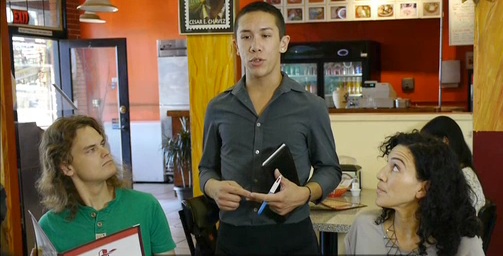READING 2c: To Interpret or Not?

As the only hearing person in a group of Deaf people, you may feel unsure about the best way to act as an ally. Eating out with Deaf friends presents one instance where it can get tricky. As you saw in the comments after each of the three choices when the waiter approached the table, not all 100 respondents agreed. In a community of individuals there will naturally be different points of view.
Some ideas to consider:
Reasons why you should immediately sign what the server is saying:
1. It happens fast. Deaf people can decide if they want to watch or not.
2. Best not to make a big deal out of it. Just sign what the server said.
3. Sign if there are specials or any other information that can not be gleaned from the menu.
Reasons why you should not immediately sign what the server is saying:
1. If the server is not saying anything unusual (name, asking for drinks, etc.)
2. To prevent the server from relying on you to do all the communication facilitation between her/him and your Deaf friends
3. To remain “equal” or show solidarity with your Deaf friends. (Which means you should order just like other Deaf people in the group, e.g. pointing to the menu, writing, typing order on phone, etc.)
Reasons why you should check with the group and see what their preference is:
1. You should never assume anything (either way)
2. It takes only a second or two to check and receive feedback from the group
3. Perhaps people in the group will have different preferences
While Deaf people eat out all the time and do just fine without any interpreters, some take extra pleasure in having a more intimate interaction with the servers, especially at a fine restaurant where part of the overall experience is the interaction with the servers regarding wine selection, chef’s specials, house specials, etc.
Likewise, Deaf people often do not realize the amount of conversations that could be overheard at public spaces like a restaurant. While hearing people usually do not want to partake in eavesdropping on conversations, some Deaf people might take delight in having you share tidbits of conversations that can be overheard.
This is the last component of the Part 2 Demo Version.
Use the green Program Navigation button on the right ![]() to navigate the Demo Versions of Part 1 and Part 3.
to navigate the Demo Versions of Part 1 and Part 3.
